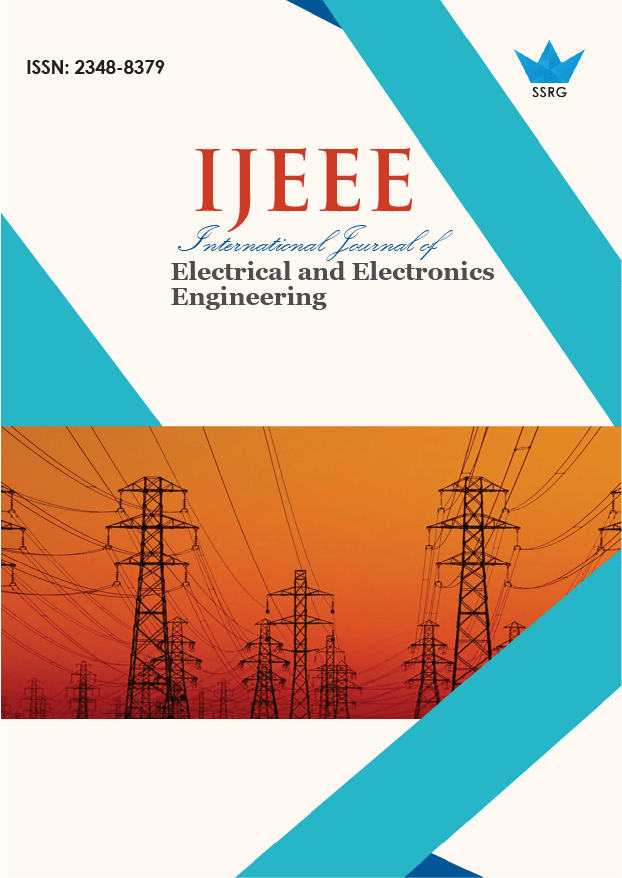Design and Performance Analysis of Slotted-Rotor-Tooth Switched-Reluctance-Motor for EV Applications using FEA Tool

| International Journal of Electrical and Electronics Engineering |
| © 2025 by SSRG - IJEEE Journal |
| Volume 12 Issue 6 |
| Year of Publication : 2025 |
| Authors : Mahesh A. Patel, Swapnil N. Jani |
How to Cite?
Mahesh A. Patel, Swapnil N. Jani, "Design and Performance Analysis of Slotted-Rotor-Tooth Switched-Reluctance-Motor for EV Applications using FEA Tool," SSRG International Journal of Electrical and Electronics Engineering, vol. 12, no. 6, pp. 118-124, 2025. Crossref, https://doi.org/10.14445/23488379/IJEEE-V12I6P109
Abstract:
Switched-Reluctance Motors (SRMs) have garnered significant interest in the realm of electric vehicle (EV) propulsion due to their unique characteristics, including ease of use, high torque density, and speed regulation capabilities. However, challenges persist, particularly in optimizing efficiency and addressing torque ripple problems associated with traditional topologies. This paper introduces a new slotted rotor-tooth switched reluctance motor (SRT-SRM) design, offering reduced weight, enhanced cooling capability, and cost savings over traditional switched reluctance motors (SRMs). The preliminary dimensions of the conventional SRM have been calculated and analyzed through a time-stepping (transient) 3-D Finite Element Analysis (FEA). In a novel topology of SRT-SRM, rotor barriers have been inserted into each rotor pole to get the benefits of higher performance of the SRM motor. It emphasizes the iterative optimization process, wherein topology modifications are implemented to minimize torque ripple and improve overall performance. The results of a novel topology (SST-SRM) have been compared with conventional SRM for validation.
Keywords:
Electric Vehicles (EVs), Finite Element Analysis (FEA), Switched-Reluctance-Motor (SRM), Slotted-Rotor-Tooth (SRT).
References:
[1] Hajo Ribberink, and Evgueniy Entchev, “Electric Vehicles - A ‘One-Size-Fits-All’ Solution for Emission Reduction from Transportation,” 2013 World Electric Vehicle Symposium and Exhibition (EVS27), Barcelona, Spain, pp. 1-7, 2013.
[CrossRef] [Google Scholar] [Publisher Link]
[2] Pankaj Kumar Dubey et al., “A State of the Art of Recent Trends in Electric Vehicles Planning,” Smart Electric and Hybrid Vehicles: Advancements in Materials, Design, Technologies, and Modeling, pp. 159-176, 2024.
[CrossRef] [Google Scholar] [Publisher Link]
[3] Tushar Suryavanshi et al., “Comparative Analysis of Switched Reluctance Motor Drive with Different Sources for Electric Vehicle,” 2024 IEEE 3rd International Conference on Electrical Power and Energy Systems (ICEPES), Bhopal, India, pp. 1-6, 2024.
[CrossRef] [Google Scholar] [Publisher Link]
[4] Zhi Yang et al., “Comparative Study of Interior Permanent Magnet, Induction, and Switched Reluctance Motor Drives for EV and HEV Applications,” IEEE Transactions on Transportation Electrification, vol. 1, no. 3, pp. 245-254, 2015.
[CrossRef] [Google Scholar] [Publisher Link]
[5] N. Zabihi, and R. Gouws, “A Review on Switched Reluctance Machines for Electric Vehicles,” 2016 IEEE 25th International Symposium on Industrial Electronics (ISIE), Santa Clara, CA, USA, pp. 799-804, 2016.
[CrossRef] [Google Scholar] [Publisher Link]
[6] B. Hemanth Kumar et al., “Control of Modified Switched Reluctance Motor for EV Applications,” 2022 Trends in Electrical, Electronics, Computer Engineering Conference (TEECCON), Bengaluru, India, pp. 123-127, 2022.
[CrossRef] [Google Scholar] [Publisher Link]
[7] L. Ananda Padmanaban, and P. Saravanan, “Design, Analysis and Comparison of Switched Reluctance Motors for Electric Vehicle Application,” Automatika: Journal for Control, Measurement, Electronics, Computing and Communications, vol. 64, no. 2, pp. 239-247, 2023.
[CrossRef] [Google Scholar] [Publisher Link]
[8] Kazuhiro Ohyama et al., “Design using Finite Element Analysis of Switched Reluctance Motor for Electric Vehicle,” 2006 2nd International Conference on Information and Communication Technologies, Damascus, Syria, vol. 1, pp. 727-732, 2006.
[CrossRef] [Google Scholar] [Publisher Link]
[9] Pavol Rafajdus et al., “Design Procedure of Switched Reluctance Motor used for Electric Car Drive,” 2014 International Symposium on Power Electronics, Electrical Drives, Automation and Motion, Ischia, Italy, pp. 112-117, 2014.
[CrossRef] [Google Scholar] [Publisher Link]
[10] Li Weili, Sheng Man, and Huo Fei, “Optimal Design and Finite Element Analysis of Switched Reluctance Motor for Electric Vehicles,” 2008 IEEE Vehicle Power and Propulsion Conference, Harbin, China, pp. 1-5, 2008.
[CrossRef] [Google Scholar] [Publisher Link]
[11] Alireza Siadatan, Narges Fatahi, and Mahsa Sedaghat, “Optimum Designed Multilayer Switched Reluctance Motors for use in Electric Vehicles to Increase Efficiency,” 2018 International Symposium on Power Electronics, Electrical Drives, Automation and Motion (SPEEDAM), Amalfi, Italy, pp. 304-308, 2018.
[CrossRef] [Google Scholar] [Publisher Link]
[12] A.L. Oliveira, A. Pelizari and A.J. Sguarezi Filho, “Finite Element Analysis Simulation of Switched Reluctance Motor Drive,” IEEE Latin America Transactions, vol. 16, no. 7, pp. 1928-1933, 2018.
[CrossRef] [Google Scholar] [Publisher Link]
[13] Hussein Ali Bardan, and Amer Mejbel Ali, “Analysis of Switched Reluctance Motor based on RMXprt, Maxwell2D and Matlab,” 2022 2nd International Conference on Advances in Engineering Science and Technology (AEST), Babil, Iraq, pp. 675-680, 2022.
[CrossRef] [Google Scholar] [Publisher Link]
[14] Lavanya Vadamodala et al., “A Modified Geometry Based Analytical Model of Switched Reluctance Motor for Rapid Design Process,” IEEE Transactions on Industry Applications, vol. 61, no. 3, pp. 3753-3763, 2025.
[CrossRef] [Google Scholar] [Publisher Link]
[15] Sufei Li et al., “Modeling, Design Optimization, and Applications of Switched Reluctance Machines-A Review,” IEEE Transactions on Industry Applications, vol. 55, no. 3, pp. 2660-2681, 2019.
[CrossRef] [Google Scholar] [Publisher Link]

 10.14445/23488379/IJEEE-V12I6P109
10.14445/23488379/IJEEE-V12I6P109